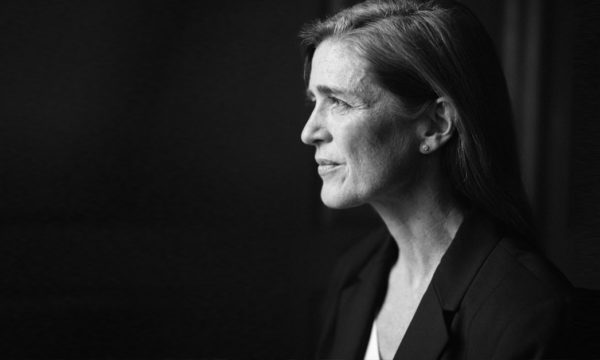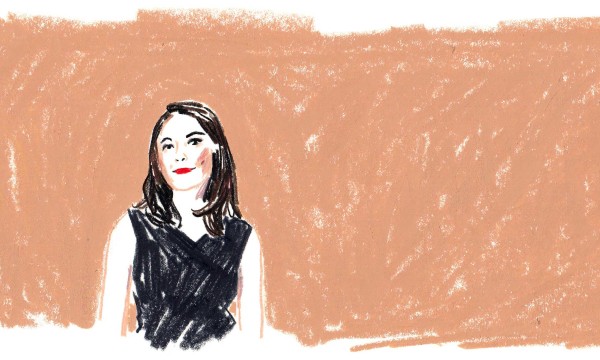
When Sarah and Miyako Met Ruth Bader Ginsburg
M.M.’s founders reflect on designing a custom jabot for RBG and what her legacy means to them as working mothers.
In the summer of 2018, M.M.LaFleur’s CEO, Sarah LaFleur, and Chief Creative Officer, Miyako Nakamura, went down to Washington, D.C. for an unusual design request. Sarah’s friend—who clerked for Supreme Court Justice Ruth Bader Ginsburg—reached out on behalf of her former clerks to commission a custom jabot to celebrate her 85th birthday and 25th year on the court. Over the years, the Justice had become known for her iconic neck accessories—including “dissenting” and “majority opinion” collars worn to mark momentous court decisions—and this was the day they’d do a custom fitting with RBG herself. They were nervous, they were excited, and they were starstruck. “It was the closest I ever came to meeting my personal God,” says Sarah.
When Justice Ginsburg passed away on September 18, memories of that day came flooding back for both Sarah and Miyako, as did a feeling of urgency—so much needs to be done to uphold the legacy of a woman who spent her life making the world a better place for the rest of us. As mothers and leaders at a company devoted to supporting working women, Sarah and Miyako don’t take any of this lightly.
Below, our founders share the story of designing the custom jabot for Justice Ginsburg, what it was like to meet her, and her legacy as a working mother and champion for women.
Want more M Dash?
Sign up for our weekly newsletter.
Thank you!
On Designing the Jabot...
Miyako: I looked at all her past collars, and they were all pretty round and beaded. I wanted to make sure that our collar was representative of the tailoring that we do at M.M., and I landed on the construction of a men’s shirt collar.
For the design, I used three ivory-colored jacquards to symbolize the familial layers that underpinned Justice Ginsburg’s life. The top layer was a textured jacquard that represented the Justice herself; below was a polka-dotted jacquard that resembled a man’s tie, which represented her husband Marty; and beneath, two layers of floral jacquard represented their children, who were blossoming under them. We felt that the collar articulated how a strong familial bond can help a woman achieve greatness at work. We also wanted to add a quote that truly represented this genuine, beautiful relationship. In 1993, the year Justice Ginsburg was nominated to the Supreme Court, her husband Marty told The New York Times, “I have been supportive of my wife since the beginning of time, and she has been supportive of me. It’s not sacrifice; it’s family.” And so the quote, “It’s not sacrifice, it’s family,” was embroidered on the collar stand of the piece.
When we did our first fitting, the jabot was too small. A couple weeks later, we brought it to her for another fitting, and I was so nervous, my hands were shaking. Once I fit it around her neck, she said, ‘Can I take a look?’ And she went into the bathroom in her office. From outside, we heard her say to herself, ‘Wonderful.’ It was a really, really beautiful moment, and it was so rewarding to feel like we delivered something that was right for her.


On Their First Impressions of RBG...
Sarah: I remember going to the bathroom multiple times before we met her. I wore the Jane dress with the stars on it. I felt like it had a slightly star-spangled banner motif. And I really debated about whether I could show my arms or not, because the Jane is sleeveless. But I thought—you know what? Of all people, I feel like she would appreciate it. She’s a woman of good style.
She was very petite. My friend Burden (who had clerked for Justice several years ago, and made the introduction) gave me this tip, which is that she talks very intentionally and doesn’t use the fillers that most people do to avoid silence in a conversation. He said, “Her sentence is not over unless you’ve counted to three.” So every time she took a pause, literally, in my head, I would go, ‘One, two, three.’ And it’s true, she had a very distinct way of speaking. It reminded me of how people communicate in Japan, where it is more common to allow for lulls in conversation. Obviously, everyone’s focus and attention was entirely on her, but for someone so important, she didn’t overwhelm the room.
Miyako: Her office had a lot of different art on the walls. It was clear that she cherished art, she cherished her craft, and the items framed in her office felt like they held so much meaning and value to her.
Sarah: There were also so many RBG-themed toys and dolls and tchotchkes displayed around her office, sent to her by her legions of fans. There was even a cake with her face on it. It felt like there was a sense of fun despite the weight of the office. She clearly had a great sense of humor.
Miyako: Every time we saw her, she was dressed really beautifully.
Sarah: For our first fitting, she showed up in this beautiful red shift dress. She was wearing these red heels, and I thought, ‘An 85-year-old woman who wears high heels, kudos to her!’ We probably spent about an hour with her. The first 20 minutes was the fitting, and so that was really Miyako at work. Afterwards, we sat down and got a chance to tell her about M.M. We had heard that she was a fashion-conscious woman who regularly had clothes tailored, but I was still taken aback when she requested an M.M. catalog so that she could see our different styles for herself. In the back of my head I remember thinking, ‘We don’t even have a paper catalog.’ We started working on one as soon as we got back to the office. So if anyone’s ever received one, you have RBG to thank.
Miyako: The second time we saw her, she was in head-to-toe gray, a total tonal look. That actually added to the intimidation-factor, because not only was she smart, but she really beautifully represented herself as well. She was an iconic woman, not just for her style, but because of all of the things she did for women—all of the ways she stood up for women, all the things that she fought for.

Shop This Look
The Thing That Surprised RBG About M.M...
Sarah: So much of what she’s fought for is equal pay and equal opportunity for women. We told her about M.M. being 80% female, which she was shocked by. We also shared our pay transparency policy, and I think she was stunned by that. She said, ‘I can’t believe that’s something that you’re doing. I’ve never heard of that. That’s wonderful.’ That reaction stuck out to me the most.
But there’s another comment I’ll never forget. When the conversation drifted to women’s rights and abortion, she said, ‘The wealthy women will be fine. They’ll always find a way to get safe abortions. It’s the poor women that we have to fight for.’ And I actually had rarely heard it framed that way—more importantly than my rights as a woman, what we’re fighting for is women’s rights for the disenfranchised, for those who don’t have the same options. That comment of hers has emboldened me.

What RBG’s Legacy Means to Them...
Miyako: Right now, everyone is aware of the need for women’s rights. Everyone is talking about it. We are all fighting as a group, and people are willing to work towards change. But I think when she was fighting for women’s rights, she didn’t have nearly as much support behind her. And it was probably such an individual passion she had that moved her to take action in spite of the challenges. It must have taken so much will. I think it’s such a difficult thing to stand for something you really, really believe in, even though the world around you is not necessarily with you. I really admire the power that she had to just push things forward.
Sarah: So much about my being able to have a baby today is deeply connected to the work that she did and fought for throughout her career. When we say we’re fighting for women’s rights, it’s not just about making things legal or illegal, although I understand that’s the ultimate outcome. Beneath the legal ruling on abortion, there is a deeper meaning in supporting women in their personal decisions around reproductive health more generally. Even though my own struggle with infertility and miscarriages was driven by this constant striving to have children, it made me as empathetic as ever for any woman’s decision to do the opposite as well. Every choice along my fertility journey was so personal and difficult, and I learned there’s so much that is completely out of your hands. It’s clear that Justice Ginsburg saw the bigger picture about what it means for women to retain what little control does exist, and how much exercising that choice is connected to personal happiness.
Miyako: I think she’s the coolest woman who ever existed. To be able to dress her in some capacity is absolutely at the top of the list of jobs I have done. Someday, I will tell my daughter that Ruth Bader Ginsburg was the woman who made it all possible. She made it possible for all of us to be able to do what we believe we should be doing as women.
Sarah: I know Supreme Court Justices are supposed to be impartial upholders of the law, but I think individually, they try to leave a legacy. And Justice Ginsburg’s legacy was about making America a better place for women. So I really hope that whoever comes next to fill that seat, that’s the legacy that person continues on the Supreme Court.

Ruth Bader Ginsburg with her husband Marty and their daughter Jane.
Photo via the Collection of the Supreme Court of the United States








